Hydrostratigraphy and Hydraulic Characterisation of Shallow Coastal Aquifers, Niger Delta Basin: A Strategy for Groundwater Resource Management
Abstract
1. Introduction
2. Materials and Methods
2.1. Description of the Study Area
2.2. Geology of the Area
2.3. Hydrogeology
3. Methodology
4. Results and Discussion
4.1. Aquifer Characterisation Using Borehole Logs
4.2. Cross-Sections from the Selected Boreholes
4.3. Hydraulic Characterisation of the Aquifers
4.4. Implications for Groundwater Resilience in Shallow Aquifers of the Niger Delta Basin
5. Conclusions
Author Contributions
Funding
Acknowledgments
Conflicts of Interest
References
- Hutton, G.; Chase, C. The Knowledge Base for Achieving the Sustainable Development Goal Targets on Water Supply, Sanitation and Hygiene. Environ. Res. Public Heal. 2016, 13, 536. [Google Scholar] [CrossRef] [PubMed]
- Cosgrove, W.J.; Loucks, D.P. Water Management: Current and Future Challenges and Research Directions. Water Resour. Res. 2015, 51, 4823–4839. [Google Scholar] [CrossRef]
- Hydrogeology, Ground-Water Quality, and Sources of Nitrate in Lowland Glacial Aquifers of Whatcom County, Washington, and British Columbia, Canada. Available online: https://pubs.er.usgs.gov/publication/wri984195 (accessed on 6 November 2019).
- Taylor, R.G.; Scanlon, B.; Döll, P.; Rodell, M.; Van Beek, R.; Wada, Y.; Longuevergne, L.; Leblanc, M.; Famiglietti, J.S.; Edmunds, M.; et al. Ground water and climate change. Nat. Clim. Chang. 2012, 3, 322–329. [Google Scholar] [CrossRef]
- Edet, A.; Abdelaziz, R.; Merkel, B.; Okereke, C.; Nganje, T. Numerical Groundwater Flow Modeling of the Coastal Plain Sand Aquifer, Akwa Ibom State, SE Nigeria. J. Water Resour. Prot. 2014, 6, 193–201. [Google Scholar] [CrossRef][Green Version]
- Niger Delta Human Development Report: United Nations Development Programme. Available online: https://www.google.com.hk/url?sa=t&rct=j&q=&esrc=s&source=web&cd=11&ved=2ahUKEwjZ-c7Pz9TlAhURGqYKHT7eCG8QFjAKegQIAhAC&url=http%3A%2F%2Fwww.bebor.org%2Fwp-content%2Fuploads%2F2012%2F09%2FUNDP-Niger-Delta-Human-Development-Report.pdf&usg=AOvVaw3elgWLtLf575CEf7eh6gQL (accessed on 6 November 2019).
- Nnabuenyi, U.M. Impact of Oil Exploration and Exploitation on the Niger Delta Region: Environmental Perspective. Niger. J. Sci. Environ. 2012, 11. [Google Scholar]
- Gordon, A.; Obenade, M. Flood Vulnerability Assessment of Niger Delta States Relative to 2012 Flood Disaster in Nigeria. Am. J. Environ. Prot. 2015, 3, 76–83. [Google Scholar]
- Gordon, A.; Gobo, A.E. Factors That Influence the Flooding of the Middle and Lower Ntamogba Stream Catchments, Port Harcourt, Nigeria. J. Environ. Hydrol. 2007, 15, 1–11. [Google Scholar]
- Ologunorisa, T.E.; Adeyemo, A. Public Perception of Flood Hazard in the Niger Delta, Nigeria. Environmentalist 2005, 25, 39–45. [Google Scholar] [CrossRef]
- Mmom, P.C.M.P.C. Vulnerability and Resilience of Niger Delta Coastal Communities to Flooding. IOSR J. Humanit. Soc. Sci. 2013, 10, 27–33. [Google Scholar] [CrossRef]
- Godleads, A.; Prekeyi, T.-F.; Megbuwe, P. Some Aspects of a Historic Flooding in Nigeria and Its Effects on Some Niger-Delta Communities. Am. J. Water Resour. 2015, 3, 7–16. [Google Scholar]
- Charles, M.; Noyes Maley, M.P.; Blake, R.G. Defining Hydrostratigraphic Units within the Heterogeneous Alluvial Sediments at Lawrence Livermore National Laboratory. Presented at Cordilleran Section-97th Annual Meeting, and Pacific Section, American Association of Petroleum Geologists, Universal City, CA, USA, 9–11 April 2001; p. 39. [Google Scholar]
- Sanz, D.; Gómez-Alday, J.J.; Castaño, S.; Moratalla, A.; Heras, J.D.L.; Martínez-Alfaro, P.E. Hydrostratigraphic framework and hydrogeological behaviour of the Mancha Oriental System (SE Spain). Hydrogeol. J. 2009, 17, 1375–1391. [Google Scholar] [CrossRef]
- Diana, M.A.; Nadine, S.; Aparna, D.; Jacek, S. Data Integration and Standardization in Cross-Border Hydrogeological Studies: A Novel Approach to Hydrostratigraphic Model Development. Environ. Geol. 2008, 53, 1441–1453. [Google Scholar]
- Asfahani, J. Hydraulic parameters estimation by using an approach based on vertical electrical soundings (VES) in the semi-arid Khanasser valley region, Syria. J. Afr. Earth Sci. 2016, 117, 196–206. [Google Scholar] [CrossRef]
- Farid, A.; Jadoon, K.; Akhter, G.; Iqbal, M.A. Hydrostratigraphy and Hydrogeology of the Western Part of Maira Area, Khyber Pakhtunkhwa, Pakistan: A Case Study by Using Electrical Resistivity. Springer Environ. Monit. Assess. 2013, 185, 2407–2422. [Google Scholar] [CrossRef]
- Adepelumi, A.A.; Ako, B.D.; Ajayi, T.R.; Afolabi, O.; Omotoso, E.J. Delineation of Saltwater Intrusion into the Freshwater Aquifer of Lekki Peninsula, Lagos, Nigeria. Environ. Geol. 2009, 56, 927–933. [Google Scholar] [CrossRef]
- Oyedele, K.F.; Ayolabi, E.A.; Adeoti, L.; Adegbola, R.B. Geophysical and hydrogeological evaluation of rising groundwater level in the coastal areas of Lagos, Nigeria. Bull. Int. Assoc. Eng. Geol. 2009, 68, 137–143. [Google Scholar] [CrossRef]
- Raji, W.O.; Obadare, I.G.; Odukoya, M.A.; Johnson, L.M. Electrical resistivity mapping of oil spills in a coastal environment of Lagos, Nigeria. Arab. J. Geosci. 2018, 11, 144. [Google Scholar] [CrossRef]
- Aturamu, A.O.; Ojo, A.O.; Adebayo, O.F.; Akinyemi, S.A. Palynostratigraphic Analysis of the Agbada Formation (Nep-1 Well) Offshore, Eastern Niger-Delta Basin, Nigeria. Br. J. Environ. Sci. Cent. 2015, 3, 19–31. [Google Scholar]
- Ophori, D.U. A simulation of large-scale groundwater flow in the Niger Delta, Nigeria. Environ. Geosci. 2007, 14, 181–195. [Google Scholar] [CrossRef]
- Owoyemi, A.O.D. The Sequence Stratigraphy of Niger Delta, Delta Field, Offshore Nigeria. Master’s Thesis, Texas A&M University, College Station, TX, USA, August 2004. [Google Scholar]
- Nwankwoala, H. Hydrogeology And Groundwater Resources Of Nigeria. N. Y. Sci. J. 2015, 8, 89–100. [Google Scholar]
- Okeke, O.C.; Onyekuru, S.O.; Uduehi, G.; Israel, H.O. Geology and Hydrogeology of Northern Ishan District, Edo State, Southwestern Nigeria. Int. Res. J. Geol. Min. 2011, 1, 1–11. [Google Scholar]
- Matthew, E.O. Hydrogeology: Groundwater Study and Development in Nigeria, Third Edit; Mecon Geology & Engineering Services Ltd.: Jos, Nigeria, 2014. [Google Scholar]
- Adelana, S.; Olasehinde, P.; Bale, R.; Vrbka, P.; Edet, A.; Goñi, I. An overview of the geology and hydrogeology of Nigeria. In Applied Groundwater Studies in Africa; Segun, A., Alan, M., Eds.; CRC Press: London, UK, 2008. [Google Scholar]
- Et, U.; Je, E. Comparison of the Characteristics of Low Velocity Layer (LVL) in the Mangrove Swamp and in the Upper Flood Plain Environments in the Niger Delta, using Seismic Refraction Methods. J. Geol. Geophys. 2016, 5. [Google Scholar] [CrossRef]
- Ugwu, S.A.; Nwankwoala, H.O. Application of seismic refraction methods in groundwater studies in Calabar Southeastern Nigeria. Sci. Afr. 2008, 7, 73–80. [Google Scholar] [CrossRef]
- Nwankwoala, H.O.; Amadi, A.N.; Ushie, F.A.; Warmate, T.A.; Eze, C.J. Determination of Subsurface Geotechnical Properties for Foundation Design and Construction in Akenfa Community, Bayelsa State, Nigeria. Am. J. Civ. Eng. Archit. 2014, 2, 130–135. [Google Scholar] [CrossRef]
- Nwankwoala, H.O.; Ngah, S.A. Groundwater Resources of the Niger Delta: Quality Implications and Management Considerations. Int. J. Water Resour. Environ. Eng. 2014, 6, 155–163. [Google Scholar]
- Offodile, M.E. An Approach to Groundwater Study and Development in Nigeria; MECON Geology and Engineering Services Ltd.: Jos, Nigeria, 1992. [Google Scholar]
- NGSA. Geological Maps of Nigeria-Nigerian Geological Survey Agency. 2012. Available online: https://ngsa.gov.ng/GeoMaps (accessed on 6 Novmber 2019).
- Mary, P.A.; William, W.W.; Randall, J.H. (Eds.) Applied Groundwater Modeling, Second Edition: Simulation of Flow and Advective Transport; Elsevier: Amsterdam, The Netherlands, 2015. [Google Scholar]
- Nilsson, B.; Højberg, A.L.; Refsgaard, J.C.; Troldborg, L. Uncertainty in Geological and Hydrogeological Data. Hydrol. Earth Syst. Sci. 2007, 3, 2675–2706. [Google Scholar]
- Gerard, B.M.H.; Peter, A.B.; Alfred, S. Propagation of Error in Spatial Modelling with GIS. Int. J. Geogr. Inf. Syst. 1989, 4, 303–322. [Google Scholar]
- Jichun, W.; Xiankui, Z. Review of the uncertainty analysis of groundwater numerical simulation. Chinese Sci. Bull. 2013, 58, 3044–3052. [Google Scholar]
- Rojas, R.; Feyen, L.; Dassargues, A. Conceptual model uncertainty in groundwater modeling: Combining generalized likelihood uncertainty estimation and Bayesian model averaging. Water Resour. Res. 2008, 44, 1–16. [Google Scholar] [CrossRef]
- Amajor, L.C. Geological Appraisal of Groundwater Exploitations in the Eastern Niger Delta. In Groundwater and Mineral Resources of Nigeria; Ofoegbu, C.O., Ed.; Springer: Berlin, Germany, 1989; pp. 85–100. [Google Scholar]
- Uma K, O. An Appraisal of the Groundwater Resources of the Imo River Basin, Nigeria. J. Min. Geol. 1989, 25, 305–331. [Google Scholar]
- Okagbue C., O. Geotechnical And Environmental Problems of the Niger Detla. Detla. Bull. Eng. Geol. Environ. 1989, 40, 119–126. [Google Scholar] [CrossRef]
- Etu-Efeotor, J.O.; Odigi, M.I. Water Supply Problems in the Eastern Niger Delta. J. Min. Geol. 1983, 20, 183–193. [Google Scholar]
- Izeze, I.A. Aquifer Characteristics of the Coastal Plain Sands of the Southern Nigeria. M.Sc. Thesis, University of Port Har-court, Port Harcourt, Nigeria, 1990. [Google Scholar]
- Nwankwoala, H. Aquifer Hydraulic Conductivity Determination from Grain Size Analysis in Parts of Old Port Harcourt Township, Nigeria. ARPN J. Sci. Technol. 2013, 3, 972–981. [Google Scholar]
- Onuoha, K.M.; Mbazi, F.C. Aquifer Transmissivity from Electrical Sounding Data: The Case of Ajali Sandstone Aquifers, Southeast of Enugu, Nigeria. In Groundwater and Mineral Resources of Nigeria; Ofoegbu, C.O., Ed.; Springer: Berlin, Germany, 1989. [Google Scholar]
- Nwankwoala, H.O.; Oborie, E.; Island, W.; State, B. Geo-Technical Investigation and Characterization of Sub-Soils in Yenagoa, Bayelsa State, Central Niger Delta, Nigeria. Civ. Environ. Res. 2014, 6, 234–240. [Google Scholar]
- Akomeno, U.O. Electric Logs for Groundwater Exploration in the Niger Delta. Chall. Afr. Hydrol. Water Resour. 1984, 144, 87–94. [Google Scholar]
- Akomeno, U.O.; Atolagbe, F.P. Saltwater Intrusion into Coastal Aquifers in Nigeria. In The Second International Conference on Saltwater Intrusion and Coastal Aquifers—Monitoring, Modeling, and Management. Mérida, Yucatán, México. Environments and the 1st Arab Water Forum; 2003; pp. 1–15. Available online: https://olemiss.edu/sciencenet/saltnet/swica2/Oteri_ext.pdf (accessed on 6 November 2019).
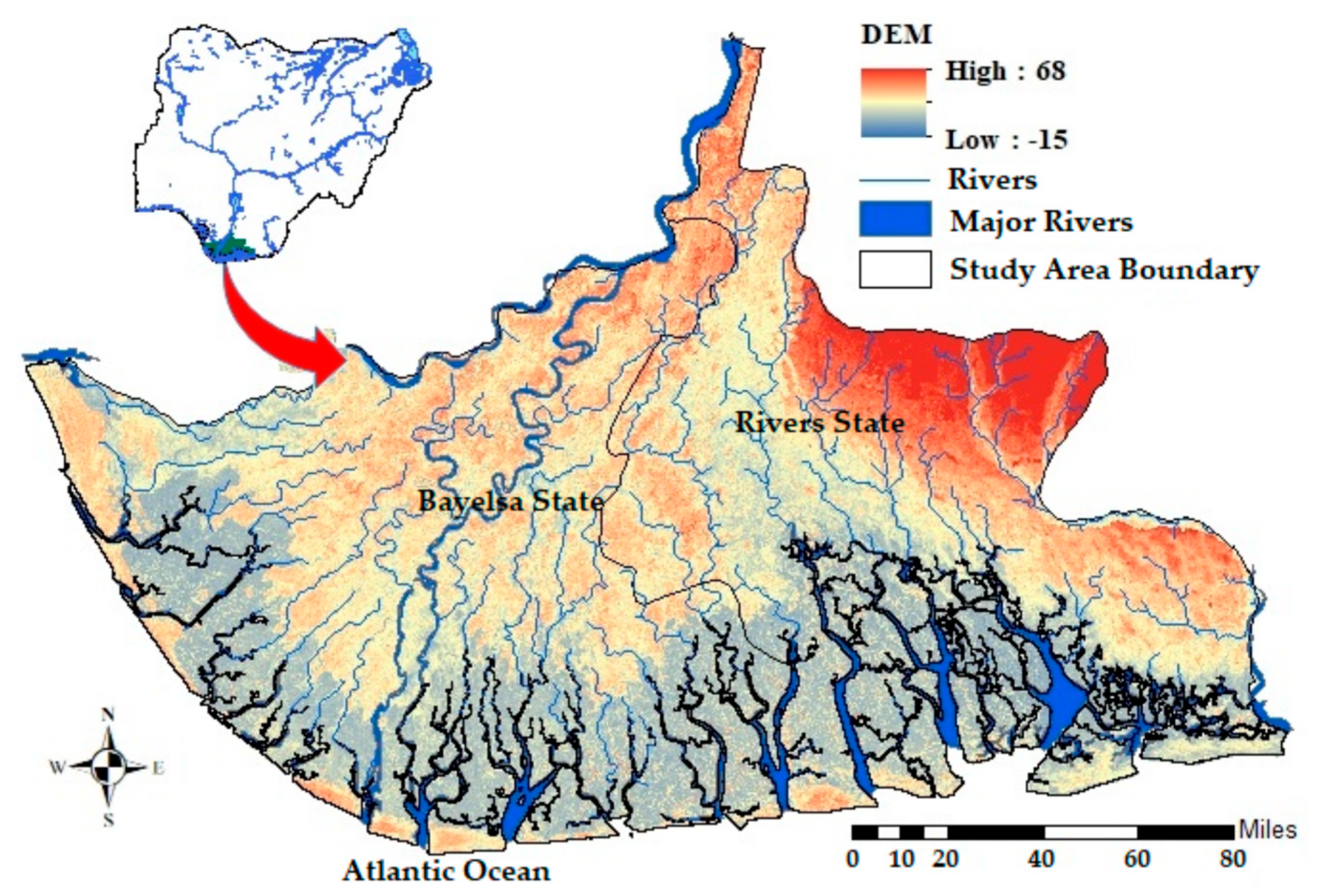
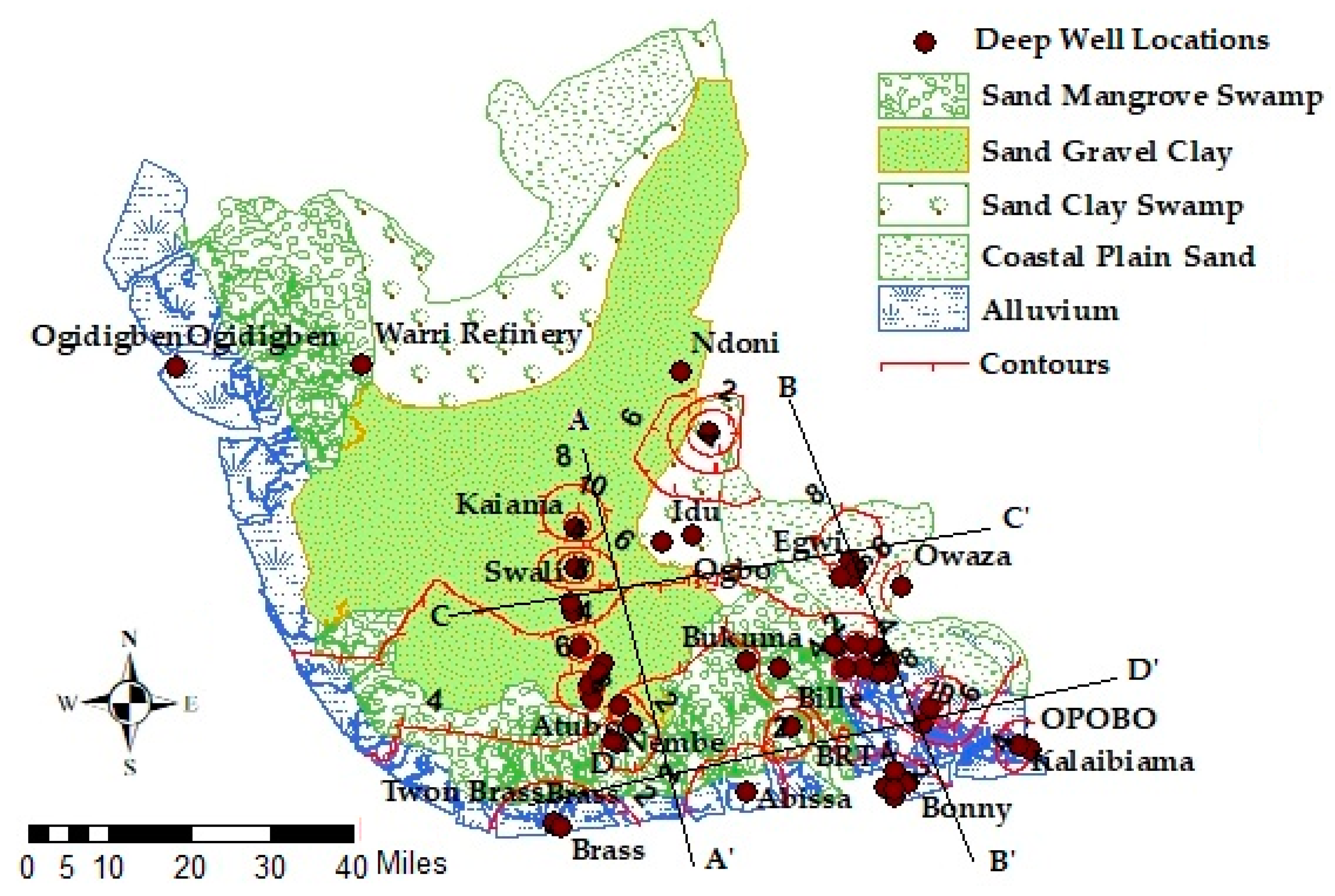
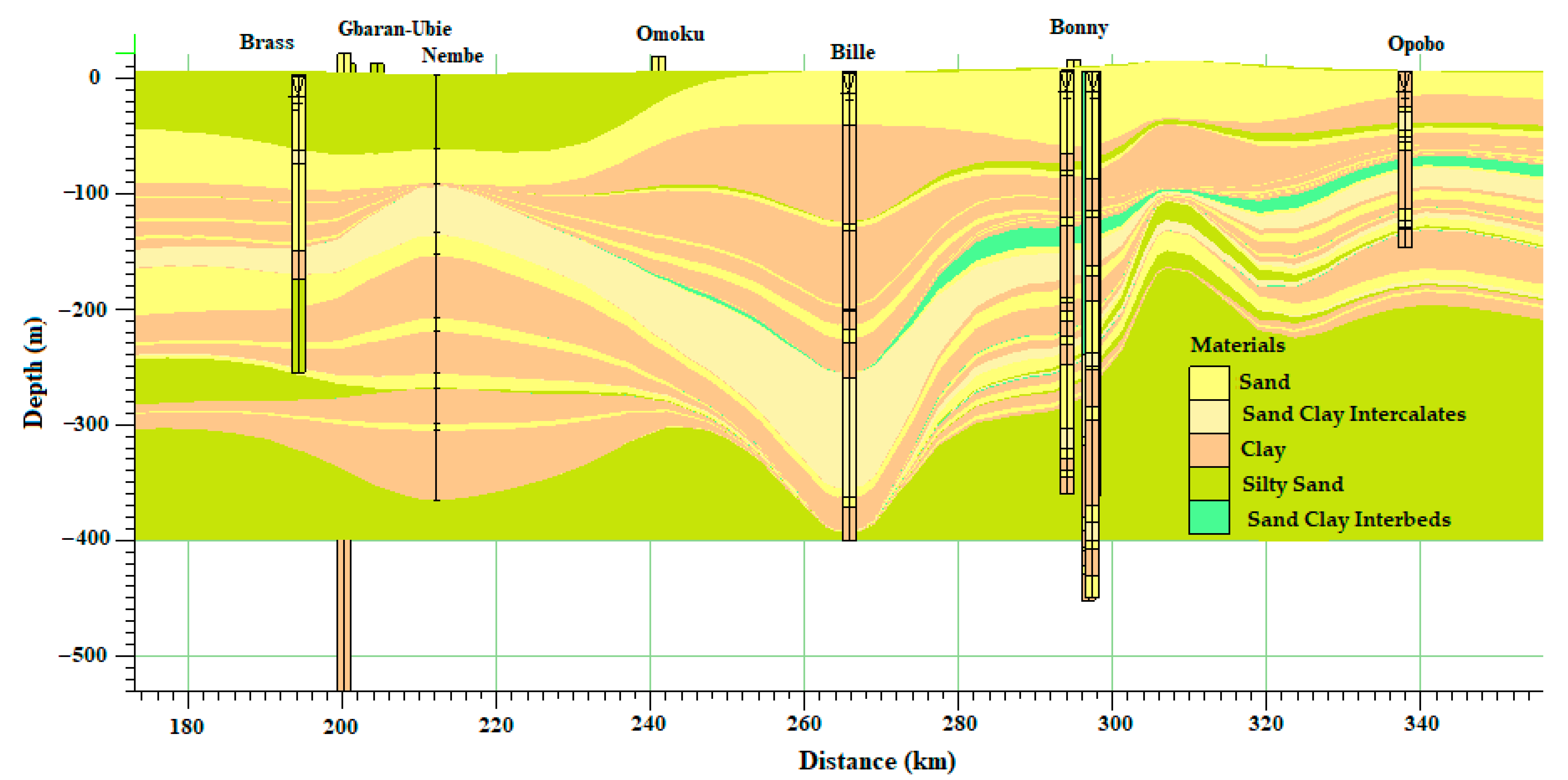
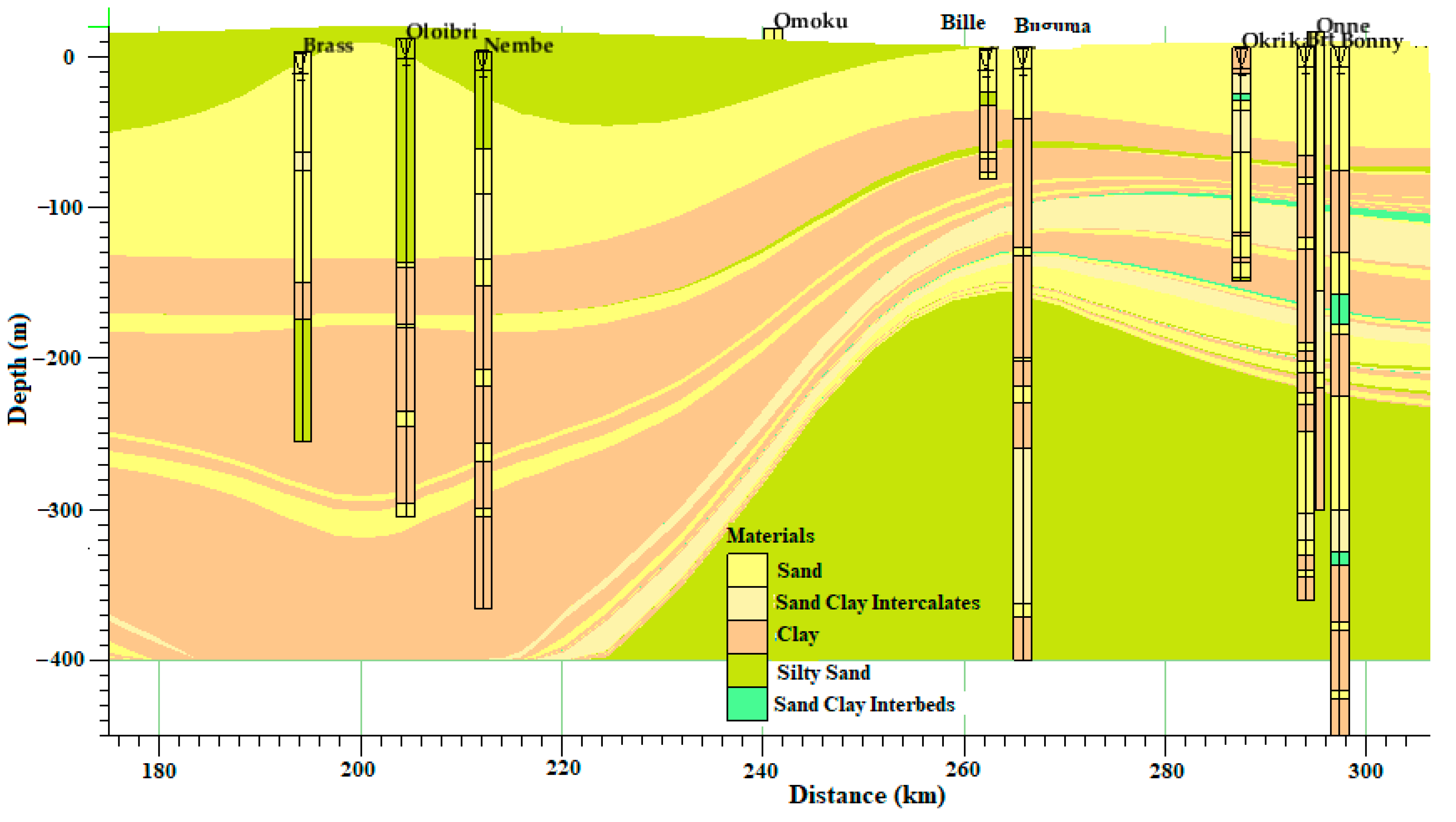
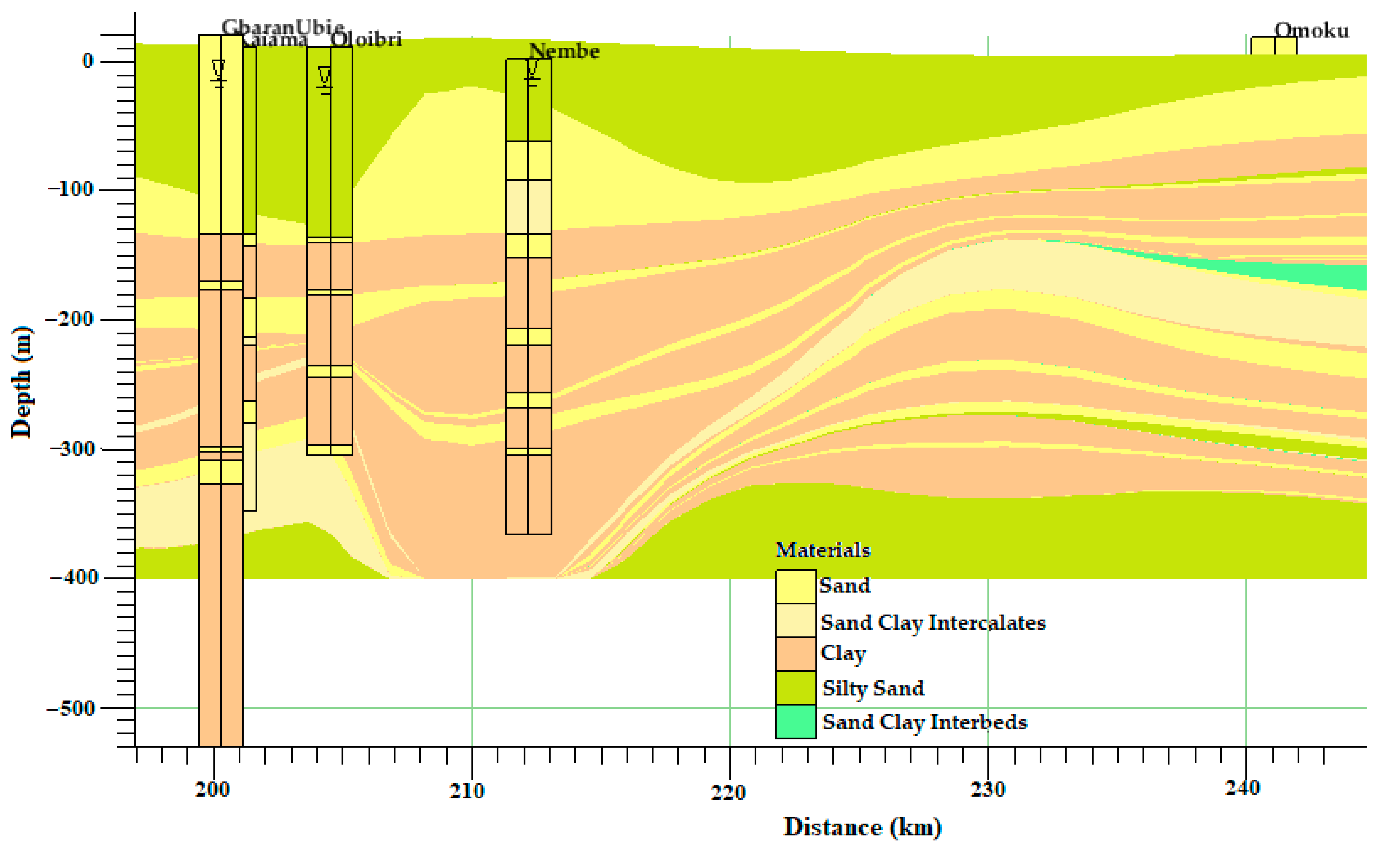

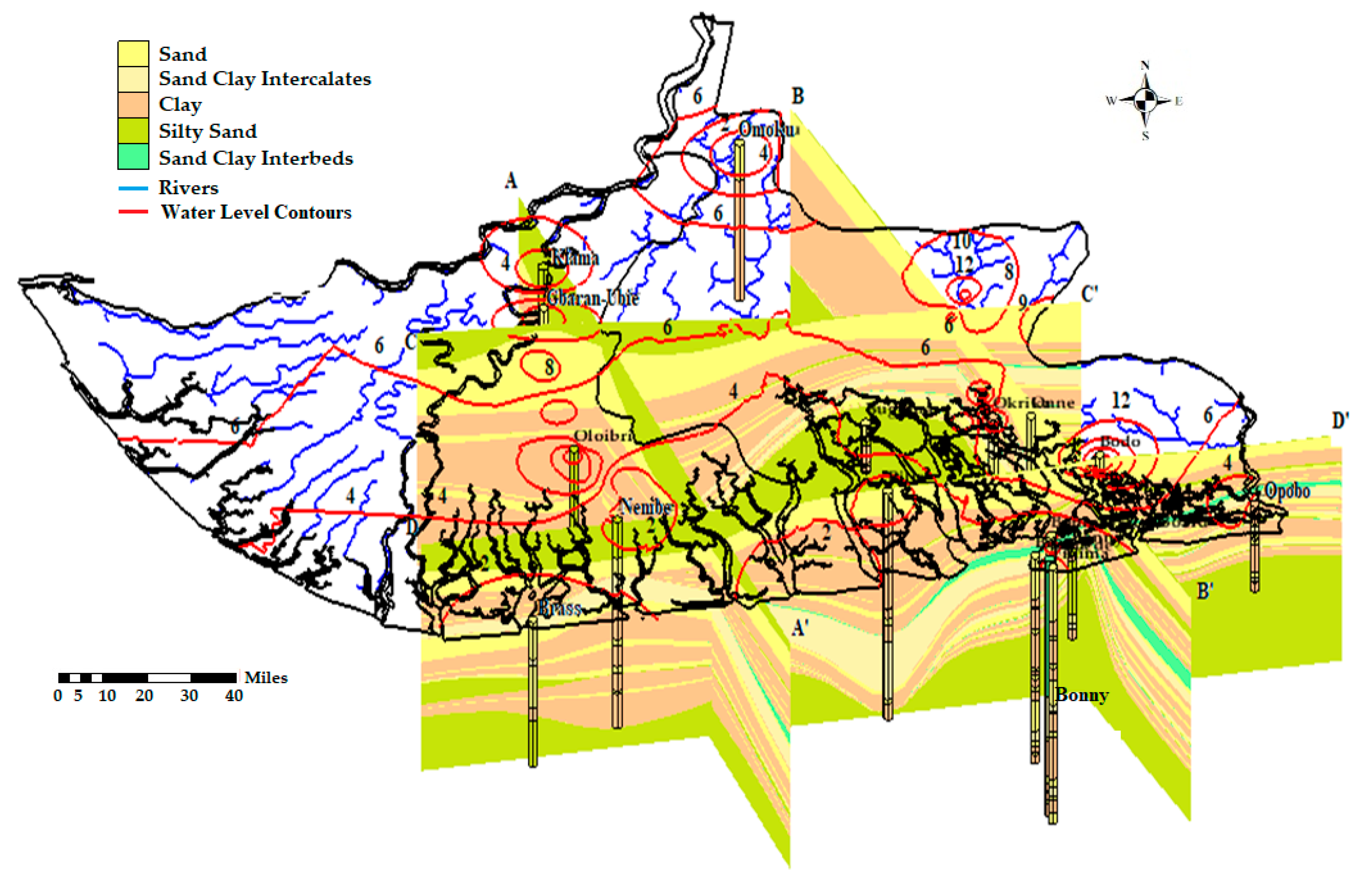
| Outcropping Units | Subsurface Units | Present-day Equivalents |
|---|---|---|
| Benin Formation | Benin Formation | Continental (fluviatile) deposits, mainly sandstones |
| Ogwashi–Asaba Formation Ameki Formation | Agbada Formation | Mixed continental brackish water and marine deposits, sandstones and clays |
| Imo Shales | Akata Formation | Marine deposits, mainly clays |
| S/No. | Borehole Location | Geomorphic Zone | Total Depth Drilled (m) | Static Water Level (m) |
|---|---|---|---|---|
| 1 | Ogbo | CPS | 186 | 7.0 |
| 2 | Edocha | CPS | 185 | 4.26 |
| 3 | Port Harcourt (Old GRA) | CPS | 207 | 5.5 |
| 4 | Ndoni | CPS | 182 | 7.55 |
| 5 | Idu | CPS | 185 | 6.2 |
| 6 | Ebubu | CPS | 92 | 6.0 |
| 7 | Azikoro | FWS | 335 | 8.6 |
| 8 | Swali | FWS | 335 | 8.8 |
| 9 | Finima (Life camp) | CBR | 360 | 1.3 |
| 10 | Onne (FOT) * | CPS | 190 | 6.0 |
| 11 | Finima (BRT) | CBR | 360 | 1.0 |
| 12 | Bassambiri | CBR | 250 | 0.8 |
| 13 | Atubo | SWS | 193 | 1.37 |
| 14 | Nembe | SWS | 195 | 2.1 |
| 15 | Ogbia | FWS | 198 | 2.5 |
| 16 | Brass | CBR | 192 | 0.69 |
| 17 | Twon Brass | CBR | 260 | 1.2 |
| 18 | Brass (NAOC Tank farm) | CBR | 256 | 0.8 |
| 19 | Otegila | FWS | 185 | 4.0 |
| 20 | Okoroba | FWS | 225 | 0.0 |
| 21 | Amakalakala | FWS | 160 | 9.14 |
| 22 | Otugidi | FWS | 426 | 0.91 |
| 23 | Otuesaga | FWS | 102 | 12.19 |
| 24 | Owaza | CPS | 152 | 3.6 |
| 25 | Kolo creek | FWS | 102 | 5.2 |
| 26 | Onne (NAFCON) | CPS | 264 | 7.49 |
| 27 | Otakeme | FWS | 300 | 4.2 |
| 28 | Omoku | SWP | 183 | 0.68 |
| 29 | Aleto Eleme | CPS | 150 | 7.75 |
| 30 | Bukuma | SWS | 183 | 1.25 |
| 31 | Kala Degema | SWS | 171 | 2.8 |
| 32 | Abissa | SWS | 147 | 0.4 |
| 33 | Bille | SWS | 193 | 0.6 |
| 34 | Opiro | SWS | 138 | 13 |
| 35 | Rumonye | CPS | 188 | 22 |
| 36 | Chokocho | CPS | 132 | 10 |
| 37 | Egwi | CPS | 201 | 8.25 |
| 38 | Umuechem | CPS | 132 | 5.5 |
| 39 | Okrika | SWS | 113 | 11.4 |
| 40 | Ibuluya-Dikibo | SWS | 180 | 8.2 |
| 41 | Bolo 1 | SWS | 92 | 5.5 |
| 42 | Abam Ama | SWS | 128 | ARTESIAN |
| 43 | Okujiagu | SWS | 110 | 0.7 |
| 44 | George Ama | SWS | 200 | 0.9 |
| 45 | Kalaibiama | CBR | 305 | 2.4 |
| 46 | Bonny | CBR | 198 | 3.0 |
| 47 | Bonny (Water Board) | CBR | 450 | 1.2 |
| 48 | Bonny (Oguede) | CBR | 460 | ARTESIAN |
| 49 | Okoloma (Afam) | CPS | 120 | 6.3 |
| 50 | Borokiri * | SWS | 190 | 2.5 |
| 51 | Gbaran-Ubie | FWS | 530 | - |
| 52 | Ogidigben/Ugorodo | CBR | 600 | - |
| S/N | Author | Hydraulic Conductivity Range | Geology |
|---|---|---|---|
| 1 | Okagbue et al. [41] | 7.2 × 10−5–2.4 × 10−3m/s | Benin Formation |
| 2 | Amajor et al. [39] | 3.91 × 10−4–4.1 × 10−4m/s | Benin Formation |
| 3 | Uma et al. [40] | 1.2 to 3.53 × 10−4m/s | Benin Formation |
| 4 | Etu-Efeotor & Odigi [42] | 4.2 × 10−7–4.1 × 10−4 | Deltaic Formation |
| 5 | Etu-Efeotor & Akpokodje [32] | 7.0 × 10−5–1.0 × 10−4 m/s | Deltaic/Alluvium Formation |
| 6 | Izeze et al. [43] | 2.01 × 10−5–5.0 × 10−5 m/s | Deltaic/Alluvium Formation |
| 7 | Okagbue et al. [41] | 2.8 × 10−7–6.3 × 10−4 m/s | Benin Formation (Ajali sandstone) |
| 8 | Onuoha & Mbazi [45] | 4.4 × 10−5–1.5 × 10−4 m/s | Benin Formation (Ajali sandstone) |
| 9 | Nwankwoala et al. [46] | 1.8 × 10−3–3.2 × 10−3m/s | Deltaic/Alluvium Formation |
© 2019 by the authors. Licensee MDPI, Basel, Switzerland. This article is an open access article distributed under the terms and conditions of the Creative Commons Attribution (CC BY) license (http://creativecommons.org/licenses/by/4.0/).
Share and Cite
Hassan, I.; Kalin, R.M.; White, C.J.; Aladejana, J.A. Hydrostratigraphy and Hydraulic Characterisation of Shallow Coastal Aquifers, Niger Delta Basin: A Strategy for Groundwater Resource Management. Geosciences 2019, 9, 470. https://doi.org/10.3390/geosciences9110470
Hassan I, Kalin RM, White CJ, Aladejana JA. Hydrostratigraphy and Hydraulic Characterisation of Shallow Coastal Aquifers, Niger Delta Basin: A Strategy for Groundwater Resource Management. Geosciences. 2019; 9(11):470. https://doi.org/10.3390/geosciences9110470
Chicago/Turabian StyleHassan, Ibrahim, Robert M. Kalin, Christopher J. White, and Jamiu A. Aladejana. 2019. "Hydrostratigraphy and Hydraulic Characterisation of Shallow Coastal Aquifers, Niger Delta Basin: A Strategy for Groundwater Resource Management" Geosciences 9, no. 11: 470. https://doi.org/10.3390/geosciences9110470
APA StyleHassan, I., Kalin, R. M., White, C. J., & Aladejana, J. A. (2019). Hydrostratigraphy and Hydraulic Characterisation of Shallow Coastal Aquifers, Niger Delta Basin: A Strategy for Groundwater Resource Management. Geosciences, 9(11), 470. https://doi.org/10.3390/geosciences9110470






